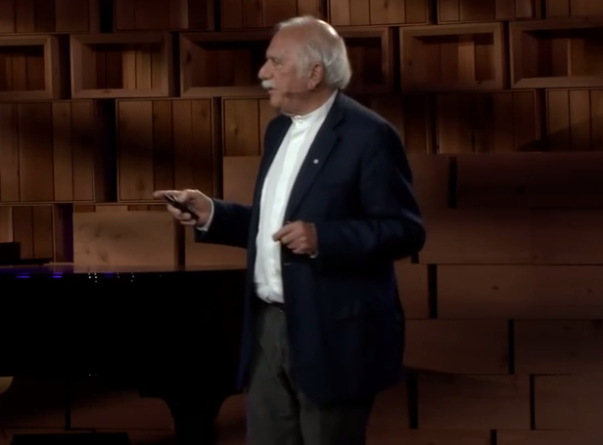(单词翻译:单击)
When, in 1960, still a student, I got a traveling fellowship to study housing in North America.
1960年,当我还是个学生,我拿到一个旅行奖学金,去研究北美的建筑。
We traveled the country. We saw public housing high-rise buildings in all major cities: New York, Philadelphia.
我们去了美国。我们在所有的大城市看到了公共高层建筑:纽约、费城...
Those who have no choice lived there. And then we traveled from suburb to suburb,
那些(大城市的)人只能住在那儿。我们从一个市郊到另一个市郊,
and I came back thinking, we've got to reinvent the apartment building.
然后我重新思考,我们需要重新设计公寓建筑。
There has to be another way of doing this.
应该有别的解决方案。
We can't sustain suburbs, so let's design a building which gives the qualities of a house to each unit.
这无法维持郊区的持续发展,我们要设计一种建筑,可以给每一个住户单元都具有房屋的特性。
Habitat would be all about gardens, contact with nature, streets instead of corridors.
居住环境要有花园,要和自然接触,有街道而不是死气沉沉的走廊。
We prefabricated it so we would achieve economy, and there it is almost 50 years later.
我们预制了每个单元来降低成本,这就是了,在距离我访美50年之后。
It's a very desirable place to live in. It's now a heritage building, but it did not proliferate.
这是个很理想的住宅。这个房子现在已经成为文物了,但没有得到推广。
In 1973, I made my first trip to China. It was the Cultural Revolution.
1973年,我第一次去中国。那时还在文化大革命。
We traveled the country, met with architects and planners.
我们到处看看,会见建造师和规划师。
This is Beijing then, not a single high rise building in Beijing or Shanghai.
这是当时的北京,在当时的北京或上海,一栋高楼都没有。
Shenzhen didn't even exist as a city. There were hardly any cars.
深圳还没设立成地级市呢。街上基本看不到汽车。
Thirty years later, this is Beijing today. This is Hong Kong.
三十年过去了,这是北京的现状。这是香港。
If you're wealthy, you live there, if you're poor, you live there, but high density it is, and it's not just Asia.
如果你有钱,那你可以住在那里。如果你不是很富裕,那你只能住在那里,不过是密度高一点。这不仅仅发生在亚洲。
Sao Paulo, you can travel in a helicopter 45 minutes seeing those high-rise buildings consume the 19th-century low-rise environment.
在圣保罗,在直升机乘上45分钟,你可以看到现代高层建筑取代了十九世纪留下来的矮房子的。
And with it, comes congestion, and we lose mobility, and so on and so forth.
随之而来的是拥挤、我们的出行拥堵,等等这类问题。
So a few years ago, we decided to go back and rethink Habitat.
几年之前,我们决定返回起点,反思什么是居住环境。
Could we make it more affordable? Could we actually achieve this quality of life in the densities that are prevailing today?
我们能不能让它更价格适宜?我们能不能在维持现有密度的情况下满足生活品质的需求?
And we realized, it's basically about light, it's about sun, it's about nature, it's about fractalization.
然后我们意识到,这主要取决于采光,取决于太阳,取决于环境。这要求我们把传统建筑变形。
Can we open up the surface of the building so that it has more contact with the exterior?
我们能不能开放建筑的几个外立面,让它跟外部环境有更好的接触呢?
We came up with a number of models: economy models, cheaper to build and more compact;
我们提出了几个方案:经济型的,更便宜而且更紧凑;
membranes of housing where people could design their own house and create their own gardens.
膜结构的,人们可以自行设计他们的房子,建造属于自己的花园。

And then we decided to take New York as a test case, and we looked at Lower Manhattan.
我们决定在纽约做个试点,我们把注意力放在了曼哈顿下城区。
And we mapped all the building area in Manhattan.
我们把所有的建筑做成图例。
On the left is Manhattan today: blue for housing, red for office buildings, retail.
左边是实际情况:蓝色的是住宅,红色的是写字楼,商场。
On the right, we reconfigured it: the office buildings form the base, and then rising 75 stories above, are apartments.
右边是我们重新规划的:底层是办公建筑,上面是75个商店,再上面是公寓。
There's a street in the air on the 25th level, a community street. It's permeable.
在第25层有一个空中步行街,是社区街道。是透光的。
There are gardens and open spaces for the community,
那里有花园和开放式空间给社区居民使用,
almost every unit with its own private garden, and community space all around.
基本上每个单元都有私家花园周围有的社区空间。
And most important, permeable, open.
最重要的是它通光,是开放式的。
It does not form a wall or an obstruction in the city, and light permeates everywhere.
没有墙或者别的遮挡,跟外界相通,所以有充足的采光。
And in the last two or three years, we've actually been, for the first time,
就在这两三年,现实生活中我们有一个横跨亚洲的项目,
realizing the quality of life of Habitat in real-life projects across Asia.
在这个项目里我们第一次真正意识到什么叫做居住环境的生活质量。
This in Qinhuangdao in China: middle-income housing,
这是在中国的秦皇岛市。这个住宅建筑是为中等收入家庭设计的。
where there is a bylaw that every apartment must receive three hours of sunlight.
有一个法规要求:所有房屋每天至少能接收到3个小时的采光。
That's measured in the winter solstice. And under construction in Singapore,
这是在冬至日测量的。这是位于新加坡的正在建造的,
gain middle-income housing, gardens, community streets and parks and so on and so forth. And Colombo.
也是面向中等收入家庭,也有花园、公共街区、公园等等。这是在科伦坡。
And I want to touch on one more issue, which is the design of the public realm.
我想再讲一点,就是公共区域的设计划分。
A hundred years after we've begun building with tall buildings,
在我们开始建造高层建筑的一百年以后,
we are yet to understand how the tall high-rise building becomes a building block in making a city, in creating the public realm.
我们仍然没有想明白为什么高层建筑反而会成为组建城市公共区域的阻碍。
In Singapore, we had an opportunity: 10 million square feet, extremely high density.
在新加坡,我们有了解决的机会:建筑面积一千万平方英尺,超高建筑密度。
Taking the concept of outdoor and indoor, promenades and parks integrated with intense urban life.
我们采用了把室内、室外,长廊跟公园,和繁忙的都市生活相整合的理念。
So they are outdoor spaces and indoor spaces, and you move from one to the other,
这里有室外空间,有室内空间,你可以到处乱逛,
and there is contact with nature, and most relevantly, at every level of the structure, public gardens and open space:
还可以去大自然接触,最主要的,在建筑的每一层都有公共绿化和开放空间:
on the roof of the podium, climbing up the towers, and finally on the roof, the sky park,
在高台的顶上,在高塔上,在楼顶有天际公园,
two and a half acres, jogging paths, restaurants, and the world's longest swimming pool.
两公顷半的空间里有慢跑道路,餐厅,还有世界上最长的游泳池。
And that's all I can tell you in five minutes. Thank you.
好像5分钟我也就只能讲这么多了呢。谢谢。


